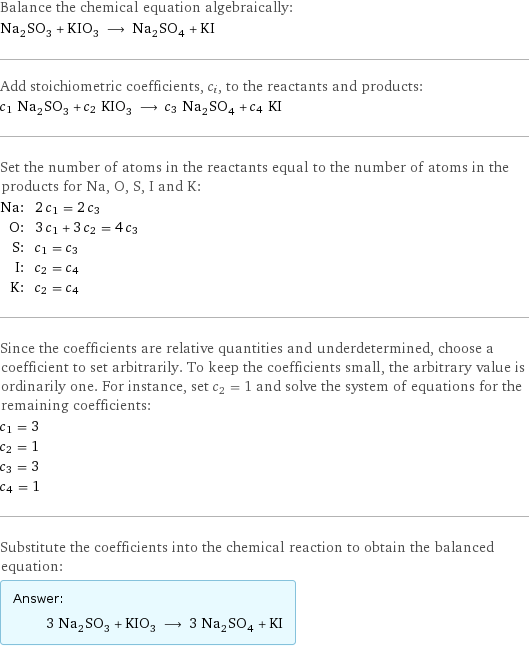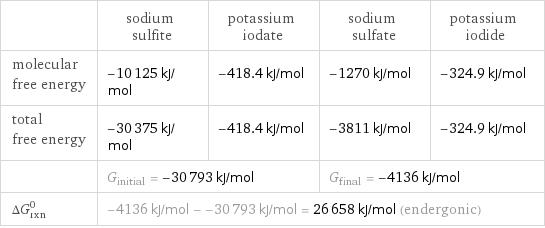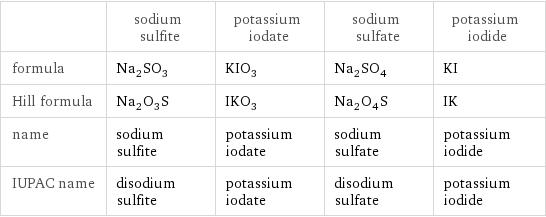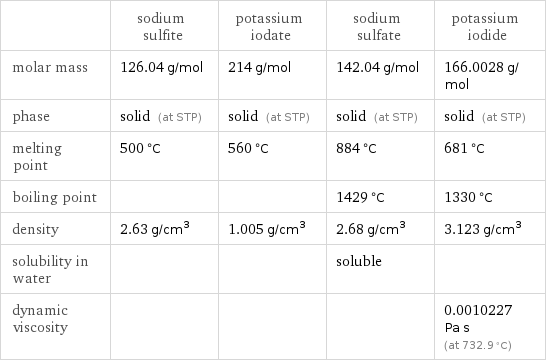Input interpretation

Na_2SO_3 sodium sulfite + KIO_3 potassium iodate ⟶ Na_2SO_4 sodium sulfate + KI potassium iodide
Balanced equation

Balance the chemical equation algebraically: Na_2SO_3 + KIO_3 ⟶ Na_2SO_4 + KI Add stoichiometric coefficients, c_i, to the reactants and products: c_1 Na_2SO_3 + c_2 KIO_3 ⟶ c_3 Na_2SO_4 + c_4 KI Set the number of atoms in the reactants equal to the number of atoms in the products for Na, O, S, I and K: Na: | 2 c_1 = 2 c_3 O: | 3 c_1 + 3 c_2 = 4 c_3 S: | c_1 = c_3 I: | c_2 = c_4 K: | c_2 = c_4 Since the coefficients are relative quantities and underdetermined, choose a coefficient to set arbitrarily. To keep the coefficients small, the arbitrary value is ordinarily one. For instance, set c_2 = 1 and solve the system of equations for the remaining coefficients: c_1 = 3 c_2 = 1 c_3 = 3 c_4 = 1 Substitute the coefficients into the chemical reaction to obtain the balanced equation: Answer: | | 3 Na_2SO_3 + KIO_3 ⟶ 3 Na_2SO_4 + KI
Structures

+ ⟶ +
Names

sodium sulfite + potassium iodate ⟶ sodium sulfate + potassium iodide
Reaction thermodynamics
Enthalpy

| sodium sulfite | potassium iodate | sodium sulfate | potassium iodide molecular enthalpy | -1101 kJ/mol | -501.4 kJ/mol | -1387 kJ/mol | -327.9 kJ/mol total enthalpy | -3302 kJ/mol | -501.4 kJ/mol | -4161 kJ/mol | -327.9 kJ/mol | H_initial = -3804 kJ/mol | | H_final = -4489 kJ/mol | ΔH_rxn^0 | -4489 kJ/mol - -3804 kJ/mol = -685.4 kJ/mol (exothermic) | | |
Gibbs free energy

| sodium sulfite | potassium iodate | sodium sulfate | potassium iodide molecular free energy | -10125 kJ/mol | -418.4 kJ/mol | -1270 kJ/mol | -324.9 kJ/mol total free energy | -30375 kJ/mol | -418.4 kJ/mol | -3811 kJ/mol | -324.9 kJ/mol | G_initial = -30793 kJ/mol | | G_final = -4136 kJ/mol | ΔG_rxn^0 | -4136 kJ/mol - -30793 kJ/mol = 26658 kJ/mol (endergonic) | | |
Equilibrium constant
![Construct the equilibrium constant, K, expression for: Na_2SO_3 + KIO_3 ⟶ Na_2SO_4 + KI Plan: • Balance the chemical equation. • Determine the stoichiometric numbers. • Assemble the activity expression for each chemical species. • Use the activity expressions to build the equilibrium constant expression. Write the balanced chemical equation: 3 Na_2SO_3 + KIO_3 ⟶ 3 Na_2SO_4 + KI Assign stoichiometric numbers, ν_i, using the stoichiometric coefficients, c_i, from the balanced chemical equation in the following manner: ν_i = -c_i for reactants and ν_i = c_i for products: chemical species | c_i | ν_i Na_2SO_3 | 3 | -3 KIO_3 | 1 | -1 Na_2SO_4 | 3 | 3 KI | 1 | 1 Assemble the activity expressions accounting for the state of matter and ν_i: chemical species | c_i | ν_i | activity expression Na_2SO_3 | 3 | -3 | ([Na2SO3])^(-3) KIO_3 | 1 | -1 | ([KIO3])^(-1) Na_2SO_4 | 3 | 3 | ([Na2SO4])^3 KI | 1 | 1 | [KI] The equilibrium constant symbol in the concentration basis is: K_c Mulitply the activity expressions to arrive at the K_c expression: Answer: | | K_c = ([Na2SO3])^(-3) ([KIO3])^(-1) ([Na2SO4])^3 [KI] = (([Na2SO4])^3 [KI])/(([Na2SO3])^3 [KIO3])](../image_source/0d5257236abdd37172b7894c113fb76e.png)
Construct the equilibrium constant, K, expression for: Na_2SO_3 + KIO_3 ⟶ Na_2SO_4 + KI Plan: • Balance the chemical equation. • Determine the stoichiometric numbers. • Assemble the activity expression for each chemical species. • Use the activity expressions to build the equilibrium constant expression. Write the balanced chemical equation: 3 Na_2SO_3 + KIO_3 ⟶ 3 Na_2SO_4 + KI Assign stoichiometric numbers, ν_i, using the stoichiometric coefficients, c_i, from the balanced chemical equation in the following manner: ν_i = -c_i for reactants and ν_i = c_i for products: chemical species | c_i | ν_i Na_2SO_3 | 3 | -3 KIO_3 | 1 | -1 Na_2SO_4 | 3 | 3 KI | 1 | 1 Assemble the activity expressions accounting for the state of matter and ν_i: chemical species | c_i | ν_i | activity expression Na_2SO_3 | 3 | -3 | ([Na2SO3])^(-3) KIO_3 | 1 | -1 | ([KIO3])^(-1) Na_2SO_4 | 3 | 3 | ([Na2SO4])^3 KI | 1 | 1 | [KI] The equilibrium constant symbol in the concentration basis is: K_c Mulitply the activity expressions to arrive at the K_c expression: Answer: | | K_c = ([Na2SO3])^(-3) ([KIO3])^(-1) ([Na2SO4])^3 [KI] = (([Na2SO4])^3 [KI])/(([Na2SO3])^3 [KIO3])
Rate of reaction
![Construct the rate of reaction expression for: Na_2SO_3 + KIO_3 ⟶ Na_2SO_4 + KI Plan: • Balance the chemical equation. • Determine the stoichiometric numbers. • Assemble the rate term for each chemical species. • Write the rate of reaction expression. Write the balanced chemical equation: 3 Na_2SO_3 + KIO_3 ⟶ 3 Na_2SO_4 + KI Assign stoichiometric numbers, ν_i, using the stoichiometric coefficients, c_i, from the balanced chemical equation in the following manner: ν_i = -c_i for reactants and ν_i = c_i for products: chemical species | c_i | ν_i Na_2SO_3 | 3 | -3 KIO_3 | 1 | -1 Na_2SO_4 | 3 | 3 KI | 1 | 1 The rate term for each chemical species, B_i, is 1/ν_i(Δ[B_i])/(Δt) where [B_i] is the amount concentration and t is time: chemical species | c_i | ν_i | rate term Na_2SO_3 | 3 | -3 | -1/3 (Δ[Na2SO3])/(Δt) KIO_3 | 1 | -1 | -(Δ[KIO3])/(Δt) Na_2SO_4 | 3 | 3 | 1/3 (Δ[Na2SO4])/(Δt) KI | 1 | 1 | (Δ[KI])/(Δt) (for infinitesimal rate of change, replace Δ with d) Set the rate terms equal to each other to arrive at the rate expression: Answer: | | rate = -1/3 (Δ[Na2SO3])/(Δt) = -(Δ[KIO3])/(Δt) = 1/3 (Δ[Na2SO4])/(Δt) = (Δ[KI])/(Δt) (assuming constant volume and no accumulation of intermediates or side products)](../image_source/8f077cc03745eb3d8571578b08767c91.png)
Construct the rate of reaction expression for: Na_2SO_3 + KIO_3 ⟶ Na_2SO_4 + KI Plan: • Balance the chemical equation. • Determine the stoichiometric numbers. • Assemble the rate term for each chemical species. • Write the rate of reaction expression. Write the balanced chemical equation: 3 Na_2SO_3 + KIO_3 ⟶ 3 Na_2SO_4 + KI Assign stoichiometric numbers, ν_i, using the stoichiometric coefficients, c_i, from the balanced chemical equation in the following manner: ν_i = -c_i for reactants and ν_i = c_i for products: chemical species | c_i | ν_i Na_2SO_3 | 3 | -3 KIO_3 | 1 | -1 Na_2SO_4 | 3 | 3 KI | 1 | 1 The rate term for each chemical species, B_i, is 1/ν_i(Δ[B_i])/(Δt) where [B_i] is the amount concentration and t is time: chemical species | c_i | ν_i | rate term Na_2SO_3 | 3 | -3 | -1/3 (Δ[Na2SO3])/(Δt) KIO_3 | 1 | -1 | -(Δ[KIO3])/(Δt) Na_2SO_4 | 3 | 3 | 1/3 (Δ[Na2SO4])/(Δt) KI | 1 | 1 | (Δ[KI])/(Δt) (for infinitesimal rate of change, replace Δ with d) Set the rate terms equal to each other to arrive at the rate expression: Answer: | | rate = -1/3 (Δ[Na2SO3])/(Δt) = -(Δ[KIO3])/(Δt) = 1/3 (Δ[Na2SO4])/(Δt) = (Δ[KI])/(Δt) (assuming constant volume and no accumulation of intermediates or side products)
Chemical names and formulas

| sodium sulfite | potassium iodate | sodium sulfate | potassium iodide formula | Na_2SO_3 | KIO_3 | Na_2SO_4 | KI Hill formula | Na_2O_3S | IKO_3 | Na_2O_4S | IK name | sodium sulfite | potassium iodate | sodium sulfate | potassium iodide IUPAC name | disodium sulfite | potassium iodate | disodium sulfate | potassium iodide
Substance properties

| sodium sulfite | potassium iodate | sodium sulfate | potassium iodide molar mass | 126.04 g/mol | 214 g/mol | 142.04 g/mol | 166.0028 g/mol phase | solid (at STP) | solid (at STP) | solid (at STP) | solid (at STP) melting point | 500 °C | 560 °C | 884 °C | 681 °C boiling point | | | 1429 °C | 1330 °C density | 2.63 g/cm^3 | 1.005 g/cm^3 | 2.68 g/cm^3 | 3.123 g/cm^3 solubility in water | | | soluble | dynamic viscosity | | | | 0.0010227 Pa s (at 732.9 °C)
Units
